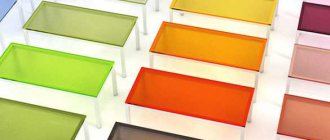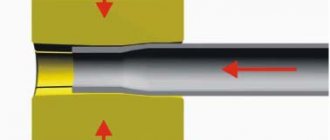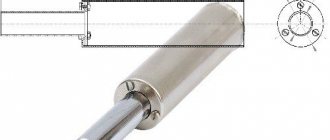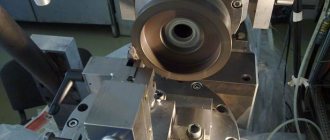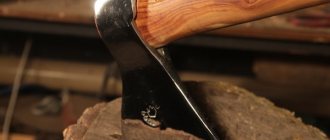How to bend glass?
Today you can find a lot of advice on the Internet about the correct finishing of plexiglass and even watch a video tutorial. But to systematize the information, it is better to first read our instructions. If you want to bend polymer glass at home, you will need the following tools and equipment.
Required equipment and bending methods
Before working with plexiglass, you need to cut out the finished part or product and its edges. It is better to take bent plexiglass with heat-resistant gloves.
In order to bend glass at home, you will need to heat it. This means you need to find a device that can quickly heat up the required area. Various devices are suitable for heating glass, from candles to a soldering iron. It all depends on the heating area, for example, small pieces of plexiglass can be heated by simply boiling them in water; for larger parts, you cannot do without a tool. Let's look at the simplest and most convenient of them.
- Heating of glass can be done using a construction hair dryer. If your material exceeds 5 mm, then we will heat it from both sides. Before heating the glass, you need to prepare some kind of template for bending, a machine made of wood, or we will simply bend it, for example, on the surface of the edge of a table. So, we direct the hair dryer to the area needed for heating. Having made sure that our material has become softer, we immediately give it a shape without waiting for it to cool. It is necessary to bend in the opposite direction from the heated side. And if you heat both sides, then the outer corner should be bent last. After the polymer glass is bent, you need to leave it aside for a while to cool.
- Nichrome wire can be used to heat the glass surface. For this process, you need to fix the glass on the edge of a workbench or table, and lay a 5 mm wire from the sheet under it. – we get a homemade thermobending machine. Nichrome is connected to a transformer and heated; after heating the wire, the polymer glass will begin to sag. You should not “help” the glass bend, as this can lead to internal stress.
- Sometimes the bend should not occur along the entire perimeter plane or the glass needs to be bent at 90 degrees. In this case, you can use a soldering iron. We mark the area with a pencil and run soldering irons over it, melting the surface a little. You need to bend the glass until it cools down.
- Sometimes glass needs to be not just bent, but given a rounded shape. For such purposes, we will need a certain remainder of the pipe around which our material will be twisted. In this case, it is better to use a blowtorch.
If you need to bend a significant area of artificial glass, then the craftsmen advise practicing on a small area. Using any bending technology, you can decorate your home with beautiful plexiglass crafts.
Those novice craftsmen who have to work with organic glass are wondering how to bend plexiglass at home without compromising its technical characteristics.
Plexiglas is a popular material that is used for interior finishing work and furniture finishing.
Plexiglas is a popular material that is used for interior finishing work and furniture finishing. Using this material, you can add uniqueness to any interior. You can easily make photo frames and transparent cases for various devices from plexiglass at home.
The use of this material is due to the presence of a whole range of advantages over ordinary glass. The main ones are the following:
- low density compared to silicate glass;
- the material is less fragile due to the presence of an amorphous structure;
- high resistance to weathering;
- high impact resistance;
- the polymer is a non-splintering material;
- high level of transparency;
- the ability to change the shape of the workpiece.
All these properties have determined the wide popularity in the use of this material both in everyday life and in industry.
Bending plexiglass
Depending on the desired result, observe the temperature regime. If you are going to bend glass, you need a temperature of 150 degrees. Plexiglas is melted at a temperature of 170 degrees.
To bend plexiglass, there are several heating methods. You can use an electric stove. This method is good for shaping sheets of glass that are not too thick.
Heating plexiglass with a hair dryer
Small parts can be “cooked” by simply holding them in boiling water for some time. Once sufficiently heated, use heat-resistant gloves to shape the parts into the desired shape.
To work with large sheets of greater thickness, it is most convenient to use a hair dryer.
Let's take a closer look at how to do this using a hair dryer:
- The first thing to remember when bending plexiglass is that the material should be bent in the direction opposite to the heated side.
- If you are bending a sheet whose thickness exceeds 5 millimeters, you need to heat it on both sides alternately, and the outer corner should be heated last.
- Having made sure that the polymer has reached the desired temperature and has become sufficiently plastic, you need to immediately give it the desired shape without waiting for it to cool, otherwise cloudiness may form at the bend, a sign of microcracks in the material. If these measures are not followed, the glass will simply break at the bend.
Before you begin the process of bending plexiglass using a hair dryer, prepare a mold or template for bending.
This could be a tabletop, a piece of pipe, a wooden block, or some other surface whose shape you want to give the glass. Heat the area needed for bending, then give it the desired shape. Next, the plexiglass product needs to be cooled properly. Do not expose glass to sudden temperature changes, as this can lead to cracking or other defects. Just leave it to cool at room temperature for a while.
Bending plexiglass according to a template
When the part has cooled sufficiently, process the edges of the product. This can be done either mechanically (using sandpaper) or thermally. For rough processing you will need sandpaper, and for finer grinding abrasive pastes are used, for example, GOI paste, as well as toothpastes and powders. When processing edges mechanically, do not forget to cool the glass surface with water.
Your product is ready, now you know how to bend plexiglass at home. We hope that with the help of this article you will be able to decorate your interior with a large number of beautiful and unique decorative items.
Preparation
Since acrylic is a synthetic material, it collects an electrostatic charge on its surface, thereby attracting dust and small particles. Surface contamination reduces the transparency of the glass. Before starting the bending procedure, the acrylic sheet will need to be washed with a soapy water solution, after which the material must be dried for at least 24 hours.
To ensure high-quality bending, it is important to properly heat the material. It is necessary to heat the plexiglass from the side opposite the bend, that is, where the surface tension of the material will be greatest
In order to prevent melting of the polymer surface of organic glass during the heating process, it is important to choose the right temperature regime. If an error occurs, the glass may not only melt, but also catch fire.
The temperature range used for heating should be between 100 and 150°C.
Bending plexiglass at home: features and nuances
Organic glass (plexiglass, plexiglass, acrylic) is a transparent thermoplastic polymer that can be easily given the desired shape, including bending at any angle with different radii.
Working with it does not require complex equipment, special tools, or special conditions, so it is quite possible to bend plexiglass at home. But there are a number of important nuances that must be taken into account in order to eliminate defects and waste of material:
• Accurate calculation. To correctly calculate the dimensions of the future part, it is necessary to take into account the bending radius. Modeling gives an excellent result - making a prototype of a part from thick paper or cardboard.
• Cleaning and drying. Organic glass is highly electrified, as a result of which it actively attracts dust and small debris, which significantly reduces transparency. Therefore, before carrying out all manipulations, it must be rinsed well with clean water and allowed to dry for 24 hours.
• Proper heating. It is necessary to heat the material from the side of greater tension - opposite to the direction of bending. In this case, the width of the heating band should have a ratio of 3:1 to the sheet thickness.
• Heating temperature. Organic glass, like any other plastic, not only bends easily under thermal influence, but can melt and even ignite. Therefore, it is critical to maintain temperatures of no more than 150 °C.
• Cooling. To avoid internal deformations, the plexiglass should cool at room temperature. The use of any emergency methods, in particular cold water, is unacceptable.
Without exception, all methods of bending organic glass require preheating. This can be local heating along the bend line or heating the entire workpiece if its dimensions are small. Also, a sheet of acrylic undergoes complete heating if we are talking about squeezing out a hemisphere or other three-dimensional figure from it using a punch and matrix.
Processing methods
Several options have been developed for bending plexiglass. The operation is carried out using:
- construction hair dryer;
- boiling water;
- nichrome wire;
- metal pipe.
The work is performed in two passes. First, preparation is carried out (we described this earlier), then bending is carried out.
Now let's get acquainted with all the methods in more detail.
Boiling plexiglass allows you to clean the material and increase its temperature, which makes it easy to bend
Boiling
This option is simple and effective; amateurs and specialists resort to it. It is performed in several stages:
- Select a container into which the workpiece can fit without any problems. Water is poured inside.
- The water in the container is heated to a boil.
- Place the plexiglass piece in boiling water and hold it for five minutes (the thicker the plexiglass, the longer it will have to be held).
- After heating, the material acquires a plastic shape, it is removed and given the desired shape.
When starting work, keep in mind that you will have to deal with boiling water and a heated part. Take necessary precautions to avoid getting burned.
Using a hair dryer
This technique is suitable for cases when you have to process an overly bulky piece of plexiglass. In this case, a professional high-power hair dryer used in construction is used to heat it to the required temperature.
To heat plexiglass, you should choose a powerful hair dryer
The bending is performed as follows:
- The plexiglass fragment is fixed motionless on the tabletop (in a vice or using clamps).
- Measure and mark the future bend line.
- The entire targeted area is heated with a stream of hot air, gradually softening it.
- Smoothly bend to the required angle.
- The curved part is cooled naturally.
wire bend
To work, you will need a special nichrome wire connected to a constant voltage source. The intensity of the source should be sufficient to heat the wire.
The process is carried out in several steps:
Application of metal pipe
Sometimes it is desirable not only to bend a plexiglass part, but to give it a special radius of curvature. You will have to use a metal pipe, heating it or the bend area. A powerful soldering iron or blowtorch is suitable for heating.
The sequence of action is as follows:
- A prepared pipe of suitable diameter is fixed in space.
- A cold plexiglass panel is placed on top of the pipe, and the area for the future bend is marked.
- The bending area begins to be heated with the selected tool.
- Bringing the material to a plastic state, they smoothly begin to bend it along the pipe, achieving a bend of the required diameter.
Using a metal pipe, you can give the plexiglass a rounded shape. If you use a soldering iron with a wide tip, then the workpiece itself should be heated. You can understand that the moment has arrived by the characteristic crackling sound that the material begins to emit, changing its properties.
Whatever method of bending plexiglass at home you prefer, be sure to ensure that all safety measures are followed. You will have to work with hot tools, boiling water or heating devices - protect yourself from burns.
The second danger is that if the heating is insufficient, the material may break, causing fragments to scatter. Competent adherence to safety precautions will protect you from injury.
Conventional glass, one of the most ancient and universally used materials, no matter how hard you try, cannot be bent. It will burst when heated. The situation is different with organic glass, thermoplastic transparent plastic, also called acrylic, acrylite.
In terms of its characteristics, high-quality synthetic polymer is practically no different from ordinary glass. However, it is convenient because it can be easily bent if necessary. What needs to be done to make plexiglass change shape? Of course, heat it up. But first it must be prepared.
How to bend plexiglass using boiling water
It is difficult to give an exact answer to the question at what temperature plexiglass bends. This is determined experimentally when heated. The optimal temperature is considered to be the one at which the material acquires sufficient plasticity for bending. At 135 °C, organic glass bends easily under its own weight. Pliable for bending, but requiring physical effort, it becomes narrower when heated to 100 °C.
Therefore, if you need to make a small part from acrylic with a curved shape or with curved edges, boiling water will come to the rescue. The workpiece is placed in a container with boiling water and, as it heats up, it is periodically checked for plasticity. As soon as the part “reaches standard”, it is quickly removed and bent. To carry out this operation, you need to prepare the necessary tools in advance (pliers, tweezers, clean rags), since the material quickly cools and loses its plasticity.
Other methods
At home, you can shape a sheet of plexiglass with your own hands. There are various ways to perform bending work, thanks to which you can bend a sheet on a nichrome string along a radius of 90 degrees, or squeeze out a hemisphere from thin acrylic. Processing of organic glass can be done using various tools.
Using a hair dryer
This method of processing acrylic is applicable in cases where it is necessary to bend a very large piece of organic glass. To properly warm up the working area, you will need a fairly powerful tool, which is a hair dryer. This high-power device blows out a stream of air heated to the desired temperature. The bending process is carried out in several stages:
- a sheet of organic glass is firmly secured to the desktop using carpentry clamps;
- take measurements and mark a line for bending the material;
- the bend area is treated with hot air supplied from a hair dryer;
- the material is treated with hot air until softened;
- the softened sheet is bent at the required angle;
- the finished product is cooled at room temperature.
In hot water
You can bend small-sized plexiglass at home using a fairly simple method, which is considered the least energy-consuming and fast - you will need water to do it. The process includes a number of steps:
- select a container so that the workpiece to be processed can fit into it, and pour water;
- bring it to a boil;
- into boiling liquid for 5 minutes. lower the acrylic blank - the exposure time also depends on the thickness of the plexiglass;
- the workpiece is heated under the influence of hot water, then it is removed from the container;
- the workpiece is bent, bringing it to the desired configuration.
The disadvantage of this method is that bending acrylic has to be done on a hot workpiece, so it is necessary to provide cotton gloves so as not to burn your hands while working.
Special nichrome wire
You can perform high-quality bending of plexiglass using nichrome thread. The procedure looks like this:
- a sheet of plexiglass is fixed on the work table using clamps, allowing the free edge to hang freely at the bend;
- nichrome wire is pulled over the table at a distance of no more than 5 mm from the surface of the sheet;
- the wire is connected to a transformer with a voltage of 24 V;
- the transformer heats the nichrome thread, and after it is very hot, the glass will slowly bend under the influence of heat and its weight.
When bending glass, you should not speed up the procedure by helping it with your hands - this can lead to cracks or deformation of the material.
Metal pipe
To give the acrylic blank a certain radius of curvature, the method of bending plexiglass on a metal pipe is used. To perform this procedure at home, you can heat either the material itself or the pipe. To heat the pipe, use a blowtorch.
The bending procedure is performed in the following sequence:
- a sheet of cold acrylic is placed on a pipe whose diameter is equal to the bend radius;
- use a blowtorch or a hair dryer to heat the folded area of the sheet;
- when the organic glass is heated and becomes plastic, turn the sheet over the surface of the pipe with your hands;
- the procedure is repeated until the acrylic sheet is bent sufficiently.
You can squeeze out a hemisphere from acrylic material. To do this, take a thin sheet of plexiglass (3-5 mm), a punch and a plywood matrix in which a hole of the required diameter is made. The diameter of the hole needs to be made a little larger, taking into account an allowance equal to the thickness of the organic glass.
To prevent the wood grain pattern from being imprinted on the acrylic blank, the punch and the surface of the plywood matrix are lubricated with casein glue, and then, when it dries, the film is sanded with sandpaper.
A sheet of organic glass is heated until softened - this can be done using a gas burner, working with cotton gloves so as not to burn your hands. After the material is well heated, it must be placed on top of the matrix. Next, a hemispherical punch is installed on top of the acrylic. Using this device, press on the acrylic sheet, then hold it for 10 minutes. the entire structure until it hardens. Thus, the plexiglass acquires a semicircular configuration. A similar technology can be used to extrude any other shape, depending on the shape of the stencil and punch.
For information on how to bend plexiglass, see below.
Creating a hemisphere from plexiglass
For these purposes, sheets with a thickness of no more than 3-5 mm are used.
Necessary equipment:
- Punch made of wood;
- A matrix made of plywood 10 mm thick, having a round hole;
- Casein glue, which is used to process the punch and matrix so that their textures are not imprinted on the product (the glue is applied to the surface and, after drying, rubbed with sandpaper);
- Heated surface (a baking tray on a stove, heated in the oven to the required temperature, will do).
Stages of work:
- The sheet heated to the required state of plasticity is applied to the matrix;
- By applying pressure with a punch installed on top and holding it in a given state for 5-10 minutes (until the material hardens), the product is given the required shape. The shape depends on the type of matrix and punch.
Regardless of how you want to bend plexiglass at home , you need to remember not only all the rules of work, but also about protective measures. It is worth considering that the work will be carried out at fairly high temperatures and with the participation of electric current. In addition, like any polymer, plexiglass has the ability to melt and can be a fire hazard. When choosing protective equipment, you should pay attention to the material from which the gloves are made and take into account that upon contact with hot plexiglass, synthetics can melt. In this regard, to protect your hands, it is better to give preference to dense natural fabrics.
In this article, we tried to answer in detail the question “ How to bend plexiglass at home .” To obtain the highest quality result, it is necessary to take into account all the nuances and correctly perform all manipulations both in preparing the product and in carrying out the actual work of bending the material. Failure to comply with the necessary conditions can lead to damage to the material and create a fire hazard.
Cooperation with our company has important advantages:
- We carry out technological operations of any complexity;
- we work with the client’s material or supply plexiglass from leading European manufacturers;
- for us there are no restrictions on the dimensions of the structure - we can work even with extremely large acrylic products;
- mechanical processing is carried out on modern equipment, the machines are equipped with numerical control;
- our production shops employ specialists with extensive experience who know all the intricacies of plexiglass processing;
- our company carries out orders of any volume - both individual and wholesale;
- We provide a guarantee for all types of work - by contacting us, you can be sure of the quality of the services provided.
Deformation process
A wire or tube is placed under the intended bend line and heated, respectively, with electricity or a burner. As the temperature rises, the glass begins to soften. When the material at the bending point is heated to a certain value, it itself will begin to bend under the influence of gravitational force and its own mass. There is no need to take any action. All that remains is to wait and remove the heating tool at the right moment.
You should not rush during the process; putting pressure on the workpiece is not recommended. Bending should occur naturally to avoid defects.
Rules and process of bending plexiglass
After carrying out the preparatory work, it is necessary to decide on the place that should be bent. Be sure to draw a line along which you want to bend the workpiece with a marker.
Let us focus on several points that must be observed before starting work:
- Since plexiglass acquires the ability to bend when exposed to high temperatures, heating equipment should be selected based on the size of the surface that you are going to bend. This means that it is not necessary to heat the entire piece of glass if you have marked one fold line - local heating is sufficient for this.
- The area to be heated must have a width that is two or more times greater than its length. Compliance with this point will significantly reduce the internal stresses of the glass after it cools.
The choice of heating source also depends on the size of the piece of plexiglass. For example, for thin sheets (up to 3-5 mm), a simple electric stove is suitable. For thick workpieces, it is better to prepare a construction hair dryer, with which you will quickly reach the required heating temperature. For plexiglass it is 150 degrees.
In addition, it is worth remembering that such thick workpieces must be heated on both sides - this is necessary in order to prevent cracks from appearing during bending.
Let's move on directly to how to bend plexiglass at home. The process can be divided into several stages.
- The entire piece of plexiglass or a separate section is heated. To do this, the material should be exposed to a heating device for some time, and so that the heated side is opposite to the direction of bending. In the case of thick sheets, the latter heats up the side on which the outer bending angle will be located.
- Reaching the required temperature is determined by eye - the material will become more pliable and slightly cloudy from the inside.
- Keep a prepared form or template on hand for bending, which can serve as either a rectangular or round surface.
- As soon as you understand that the material is ready, it must be bent immediately, it is advisable to use a minimum number of movements and obtain the required shape as quickly as possible, without allowing the material to cool. If you miss this moment, then microcracks may appear in the structure of the plexiglass, which subsequently begin to destroy the part from the inside.
Very small pieces can be modified by simply leaving them in boiling water for 5-7 minutes. The material will have time to soften so much that you can give it a completely different shape with your own hands. A prerequisite here is to work in special gloves that will not allow high temperatures to damage your limbs.
By the way, it is worth noting that plexiglass can also be melted at home. Only for this it needs to be heated even more - at least to 180 degrees. This can be done to make polymer glass castings.
The casting forms prepared in advance can be different, but the glass itself in the molten state spreads well and completely fills even the thinnest areas of the mold. Before casting, you need to ensure that the mold is cleaned of dirt in order to avoid both the unsightly appearance of the resulting casting and possible defects that dirt can cause.
Preparing plexiglass for bending
Before bending plexiglass at home , you need to perform several steps:
- Flushing. This is carried out with running clean water or a soap solution followed by rinsing.
- Drying. Carry out at room temperature for 24 hours, or using a hair dryer, as described above.
- Fixing the workpiece. For these actions, a vice or other available means are used. It must be remembered that the contact points between the glass and the clamping device must be insulated with a soft gasket to avoid the formation of scratches and abrasions.
Ways to bend at home
Necessary materials
In order to give the plexiglass the desired configuration, you can use one of several popular methods:
- Heating the material using a hair dryer;
- By boiling;
- Using nichrome wire.
Depending on the method of bending the plexiglass, you will need a heating element (a hair dryer, nichrome wire or a saucepan with boiling water). In addition, prepare:
- Hacksaw for metal;
- Vise for reliable fixation of the plexiglass plate;
- Shape for bending (pipe, block, tabletop, etc.);
- Abrasive material for grinding the edges of the product;
- A little water (to cool the material while cutting it).
Preparatory work
If your future product requires the use of a small piece of plexiglass, then you first need to cut it off from the overall fabric. To do this, securely fix the plexiglass in a vice and cut the required piece with a hacksaw. In the places of fixation, do not forget to lay soft material that will prevent damage to the plexiglass.
To cut plexiglass, you can use either a hand saw or a jigsaw.
Important: use only a sharp hacksaw. Otherwise, the material may be damaged and deformed. When cutting plexiglass, cool the cutting line with water
This will avoid overheating of the plexiglass and its possible melting.
Cool the cutting line with water while cutting plexiglass. This will avoid overheating of the plexiglass and its possible melting.
Bending by boiling method
This is the easiest way to bend plexiglass, requiring virtually no additional tools.
- Take a container of water and put it on fire.
- Bring the water to a boil.
- Dip the workpiece into it and boil for 3-5 minutes.
- Then remove the well-heated material from the water and bend it in the desired direction.
5. Leave the part formed from plexiglass until it cools completely.
Using a hair dryer
If you have to bend a fairly large piece of plexiglass, then use a hair dryer for this purpose. Its power will allow you to process a large area of organic polymer material in an extremely short time.
- So, we place the plexiglass sheet in a vice, having previously laid out the fixation points with a soft cloth.
- We carefully warm up the intended fold line with a construction hairdryer.
- As soon as the material becomes plastic, we begin bending it using a pre-prepared shape (pipe, block, tabletop).
- Leave the finished part until completely cooled.
Using nichrome wire
Using nichrome wire carefully stretched under plexiglass, you can bend the material in a straight line without effort. To do this you need to do the following:
- Fix the plexiglass sheet on one side on a workbench or table so that the fold line is as close as possible to the edge of the table or workbench.
- Place the nichrome wire under the intended fold line so that it does not come into contact with the surface of the plexiglass, but is at a distance of at least 5 mm from it.
- Connect the nichrome filament to the transformer and wait until it glows.
- When the nichrome wire heats up, its heat is transferred to the organic glass. In turn, the heated material in the bend line will begin to bend under its own weight. In this case, to prevent possible bending to a large side, place a limiter in the form of a bar or other persistent surface on the bending side of the plexiglass. The bent glass will take the specified angle.
- Leave the finished part to cool completely.
Video: bending plexiglass with nichrome wire
We bring to your attention a short video that will clearly demonstrate how to bend plexiglass using nichrome wire.
As you can see, the process of bending organic glass is not as complicated as it might seem at first glance. Having studied the techniques of work and completed a short “production practice”, you will probably very soon be able to quite professionally produce the parts and products you need. In addition, working with such a polymer material opens up great scope for creating unique masterpieces of design art. Especially if you use colored glass in your work. So, a well-chosen shade of material and some effort in tandem with imagination can completely transform the decor of your home. Dare, try and be satisfied with the results of your efforts!
Other methods of bending organic glass
To bend organic glass, place it in boiling water for 1 minute. Then they take out the material and immediately bend it, putting silicone gloves on their hands. There are also many other ways to bend glass at home using improvised means:
- Gas-burner. Using a torch, making a bend is very easy; just heat the organic glass in a certain place. To ensure that heat gets exclusively to the bend, a tin can should be attached to the gas burner, with a hole similar to a slit cut out at the bottom.
- Soldering iron. Using a soldering iron to bend organic glass, you can get a high-quality and precise bend. But before you start the main work, you need to practice.
- Hot pipe. Before bending glass with a hot pipe, it must first be prepared and wiped with a soda solution.
When working with plexiglass, you need to learn one important rule: in order to bend this material, it needs to be softened in a certain place. You can use any heat source for this.
The shape of the material changes just as easily; you just need to put in a little effort, and an unremarkable strip of plexiglass will turn into a real work of art, you just need to heat it to the required temperature.
Now you know what this material looks like, what it is and what characteristics it differs from, which means you will be able to cope with the task by figuring out how to bend plexiglass.
Plexiglas is a solid synthetic transparent material that is made from organic polymers. Organic glass is used to construct aquariums and shelves, as well as glazing greenhouses, doors and decorative trim. Since this material is a thermoplastic, it becomes plastic when exposed to high temperatures. It is thanks to this property that plexiglass is flexible.
The process of bending organic glass: 1 - heating, 2 - bending at right angles, 3 - bending into a tube.
Characteristics of Plexiglas Bending Machine
Machines for bending plexiglass have a variety of models: intended for personal use or for industrial use.
For personal purposes, manually driven machines are used. There is also a foot drive, which frees your hands and is more convenient.
Industrial machines for bending acrylic are produced with an electromechanical or pneumatic drive.
The operating principle of all bending machines for plexiglass (thermal designers) is the same for all manufacturers:
Thermobending machine
- heating the acrylic surface;
- hot bending;
- cooling.
A special feature of plexiglass is its plasticity. When hot, it can be given any shape. Upon subsequent cooling, it retains this new shape.
Machines for bending plexiglass differ only in productivity, complexity and accuracy of work.
The new model of the Thermal Designer bending machine allows you to:
- install and maintain 16 lines simultaneously;
- microprocessor ensures high accuracy of heating time and temperature adjustment;
- The device is powered from a 220-volt electrical network, and the power consumption does not exceed 0.8 kW.
Variety of equipment options
There are quite a lot of configuration options for a machine for bending plexiglass.
The standard version contains:
- 2 main heating lines;
- 2 spare strings for bending;
- string length 1000 mm;
- the machines are equipped with a mini-table 80 mm wide and a stop-conductor, which move freely and are secured with screw clamps;
- digital countdown timer has light and sound alarm;
- More tables can be installed if necessary by completing the machine. Thus, the table surface can be increased to 400 mm.
Master1000-17 - standard machine for bending acrylic.
Some models have an upper frame, which allows heating the surface of the material for bending on both sides. This option is necessary for thermobending thick plexiglass.
Warming up is carried out in a gentle mode. This saves electrical energy and extends the service life of the string.
The gap between the nichrome wire and the surface of the plexiglass is smoothly adjustable in the range of 9 mm with a visual indicator.
Plexiglas bending machine - complete set
How is it possible to process plexiglass?
Plexiglas is lightweight, but at the same time it is highly durable and can be available in various colors. It is used to make accessories for the bathroom, kitchen, and you can even use it to build a gazebo in the courtyard of a private house. And that’s not all - plexiglass serves as a material for the manufacture of product cases, decorative panels, three-dimensional figures and letters; it is used for “modding” computer cases and dynamic lighting installations. A characteristic feature of plexiglass is that the flow of light spreads evenly in it; at night it looks very beautiful. Thus, plexiglass is used everywhere, but it must be processed in a way convenient for you.
The main advantages of plexiglass:
- transmits light well - 92%, this indicator does not change over time, and the product itself does not lose its color;
- high impact resistance - five times more than glass;
- moisture resistance;
- harmless to the environment, no harmful gases are released when it burns;
- processing plexiglass is a simple process;
- can take different shapes when exposed to an industrial heat gun, the optical properties will not change, the detailing is very good;
- mechanical processing of plexiglass is no more difficult than wood;
- stable in the external environment;
- not afraid of low temperatures;
- 73% of ultraviolet rays penetrate through it, from which the material does not change color or deform;
- resistant to chemical influences;
- has electrical insulation properties.
Processing plexiglass must be done very carefully, otherwise it can be scratched very easily. But at the same time, it has an undeniable advantage over ordinary glass - plexiglass does not break and can be given any shape. To accurately process this material, you need to know how this can be done, have a special machine and tools.
Processing plexiglass must be done very carefully, otherwise it can be scratched very easily. But at the same time, it has an undeniable advantage over ordinary glass - plexiglass does not break and can be given any shape. To accurately process this material, you need to know how this can be done, have a special machine and tools.
This glass is distinguished by the fact that it is at the same time beautiful, transparent, durable and not heavy; in some cases it is suitable for replacing glass and plastic. Processing of plexiglass can be carried out by sawing, planing, turning. Its cutting differs depending on the conditions under which it is carried out - on special equipment in a workshop or at home. It is important not to scratch it to prevent microcracks.
Plexiglas can be produced using one of two methods: extrusion (extruded plexiglass) or casting (cast, cast plexiglass).
Processing of plexiglass can be done by cutting, drilling, grinding, milling, polishing, welding and gluing. In order to create a specific design for a product, thermoforming (hot forming) and cold bending are used.
Using a metal pipe
This method is used if it is necessary to give the workpiece not just a bend, but a certain radius of curvature, and is also applicable at home. In this case, a metal pipe is used as a blank of the required radius. To carry out the operation, either the pipe itself or the bend is heated using a powerful soldering iron with a wide tip or a blowtorch.
Bend using a metal pipe
The sequence of implementation of the technological process is as follows:
- A cold sheet of organic glass is placed on top of a pre-fixed pipe. Mark the starting point of the bend.
- Using a blowtorch or soldering iron, gradually heat the bend area. When the material becomes soft, manually carefully turn the sheet along the pipe, bending it to the desired angle. Using a soldering iron allows you to heat the bending area to the maximum temperature. This moment is easily determined by the crackling sound of the material.
If another option is used, the pipe is first heated and then a sheet of plexiglass is applied. A bend is made around the heated pipe.
Using any of the listed methods involves working with such hazardous factors as:
- instruments and devices connected to high voltage;
- high temperatures;
- possible appearance of fragments when glass breaks (with insufficient heating).
Drawing of a bending machine for plexiglass
Therefore, in order to protect yourself during this work, you must follow safety regulations.
Plexiglas processing workshops use hot stamping method
Thermal processing of plexiglass allows you to create large products with intricate contours, which require inexpensive, simple forms. As a rule, sheet blanks act as the starting material.
This processing method includes three stages: heating, molding and cooling. When the temperature of plexiglass reaches a certain value, it becomes plastic, which makes it possible to give the material the desired shape using special tools. The glass then cools and becomes hard again, but in a new form. If you notice that the plexiglass has not taken exactly the form that you wanted, then it can be melted again and the inconsistencies can be eliminated if it has not been stretched. Plexiglas is heated in special heating cabinets and infrared heaters, which create a uniform temperature field with a difference across the plane and thickness of the sheet of no more than +3 to -3 °C. For every 1 mm of material thickness, plexiglass is heated for 3-4 minutes to a temperature of 140–190 °C.
It is permissible to mold plexiglass figures using the contact method, that is, by contacting the working (optical) surface of the hot material with the forming surface, or non-contact, when the contact of the surfaces occurs only in the zone of technological allowances. The chosen method depends on the shape of the product and its purpose. The non-contact processing method allows one to obtain better optical characteristics, but with a smaller variety of shapes.
Attention! It may happen that you receive a product that is smaller than required. To prevent this, it is necessary to take into account shrinkage: when casting - 2% in length and width; during extrusion - from 3 to 6% or from 1 to 2%, depending on the direction of extrusion.
Before heating and hot stamping, it is necessary to remove the protective film from cast glass, otherwise after exposure to high temperatures this will be almost impossible. But this does not apply to extruded plexiglass. It is recommended to leave the protective film only in cases where it is absolutely undamaged and has no bubbles, which means it will not leave marks on the finished product.
It is necessary to get rid of moisture by processing in a drying oven at a temperature of 75–80 ° C for one to two hours per mm of thickness.
I would like to note: even at the maximum temperature, significant pressure must be applied to deform cast glass, and very little force is required to deform extruded glass.
There are cases when plexiglass products are made at home using an industrial hair dryer.
Deformation of plexiglass using a hair dryer (photo):
Bending plexiglass - description of the process
There are several methods for giving the desired shape to this material, and each of them will require its own tools and devices. Next - about each of these methods and about the preparatory operations (which are common).
Technology
Before processing, acrylic glass must be well cleaned, without the use of abrasives and aggressive chemicals. It is only permissible to use gasoline (kerosene) to remove oil stains, if any. Acetone and other solvents can ruin the material, so they are not used.
Then it is advisable to dry the plexiglass sheets - the thicker it is, the longer it will take to do this. One millimeter of thickness takes an hour and a half (on average). The temperature should be about 80 degrees. Thorough drying is especially important when the plexiglass sheets were stored in humid conditions.
Now all that remains is to fix the prepared sheet well, and then use one of the methods listed below. Most of them involve heating the surface to be bent, but there is also a cold method.
Cold bending
Acrylic glass is so flexible that it can be bent even without heating. But the radius should not be too small. The minimum is the sheet thickness multiplied by 230. Therefore, the cold method has limited use - for example, complex small-sized products cannot be made with it. Even ordinary corners.
Thermobending
In this case, local heating occurs at the place where the future bend is located. By changing the width of this place, it is possible to adjust the bending angle. You can use the following as a heat source:
- a construction hairdryer (directing its jet not across, but along the fold);
- hot nichrome wire (string);
- a special machine - a thermal designer.
There is another method called molding. It consists of heating the entire surface of the sheet (which should be no thicker than 10 centimeters). However, this is too expensive, so it is rarely used.
How to bend the material correctly?
Heating on only one side is permissible only with a plexiglass thickness of up to five or six millimeters. If it is thicker, then you will have to heat it on each side in turn. However, machines usually have the ability to heat on both sides - this is very convenient.
General note: the width of the heated zone should not be less than three times the thickness of the acrylic sheet. In this case, the sheet bends not in the direction from which the heat comes, but in the opposite direction.
Uniform cooling of the material is also important - it should not occur very quickly. As a rule, it will take two thirds of the time it took to heat up.
The temperature of the cooled acrylic will be 60 or 70 degrees.
Radius bending
This method is applicable when you need to work with large sheets. To do this, a metal pipe is selected according to the required bending radius. There should be no traces of rust or paint on it. This pipe is firmly fixed and then heated to a high temperature (90 to 100 degrees).
A sheet of plexiglass, treated with a soda solution, is attached to the pipe using clamps and wrapped around it. Thus, the product acquires the desired shape, fixed after cooling.
Temperature
It is worth remembering that there are two types of acrylic glass, differing in the manufacturing method. This is extrusion and injection molded plexiglass. The latter has a higher molding temperature - from 150 to 170 degrees. For extruded material it ranges from 150-155 degrees. Therefore, before work you need to clarify the type of plexiglass.
Accordingly, our task is to heat the material exactly to these temperature values. Under no circumstances should you overheat - otherwise, instead of bending, we will get a shapeless molten mass. You should consider a range from 140 to 160 degrees - this is what experts advise. In this case, you will have to apply a minimum of physical force.
Why choose plastic?
- He has served for over ten years.
- Polycarbonate is not afraid of either frost of forty degrees or heat of one hundred and twenty degrees.
- Panels can be processed in different ways and with available tools. When cutting, the edges are not sharp and safe for humans.
- Plastic will protect you from street and highway noise and create a comfortable, quiet place for you to relax.
- It can be bent when heated or cold, creating structures of complex shapes. If everything is done correctly, the material will not crack.
- Polycarbonate allows 90 percent of sunlight to pass through.
- The panels are much lighter than glass and other building materials.
- The material can withstand heavy snow and wind loads.
